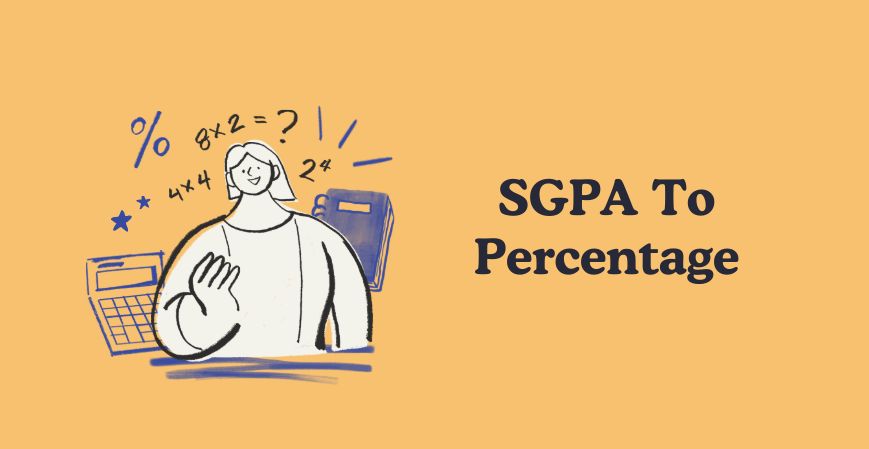
In modern education systems, particularly in universities that follow the Credit-Based Grading System (CBGS) or Choice-Based Credit System (CBCS), student performance is often measured using SGPA (Semester Grade Point Average) rather than traditional percentage marks.
While SGPA provides a precise indication of academic achievement, many students and employers still prefer to view scores in percentage form. This creates a common question: “How do I convert SGPA to Percentage?”
This article explains the concept of SGPA, how it is calculated, and how to accurately convert SGPA into percentage for different universities and boards.
What is SGPA?
SGPA (Semester Grade Point Average) is the weighted average of grade points obtained by a student in all courses during a particular semester. It reflects a student’s overall academic performance for that semester.
Formula to Calculate SGPA:
SGPA=∑(Credit×GradePoint)∑Credits\text{SGPA} = \frac{\sum (Credit \times Grade Point)}{\sum Credits}
Where:
-
Credit = weight assigned to each subject based on its importance or workload.
-
Grade Point = numerical value corresponding to the grade earned (e.g., A = 9, B = 8, etc.).
Difference Between SGPA, CGPA, and Percentage
| Term | Meaning | Scope |
|---|---|---|
| SGPA | Average grade points earned in one semester. | Calculated per semester. |
| CGPA | Cumulative Grade Point Average over all semesters. | Calculated for the entire course. |
| Percentage | Marks obtained out of 100. | Traditional measure of performance. |
In essence:
SGPA → Percentage (for one semester)
CGPA → Percentage (for the entire program)
SGPA to Percentage Conversion Formula
Different universities and institutions may use slightly different formulas for conversion, but the most common and widely accepted formula is:
Percentage=(SGPA−0.75)×10\text{Percentage} = (\text{SGPA} – 0.75) \times 10
Example:
If your SGPA is 8.2,
Percentage=(8.2−0.75)×10=74.5%\text{Percentage} = (8.2 – 0.75) \times 10 = 74.5\%
This means an SGPA of 8.2 is equivalent to 74.5%.
Alternative SGPA to Percentage Conversion Formulas (University-Wise)
| University / Board | Formula for Conversion |
|---|---|
| Anna University | (SGPA × 10) – 7.5 |
| Mumbai University | (SGPA – 0.75) × 10 |
| Jawaharlal Nehru Technological University (JNTU) | (SGPA – 0.75) × 10 |
| Visvesvaraya Technological University (VTU) | (SGPA – 0.75) × 10 |
| Delhi Technological University (DTU) | (SGPA – 0.75) × 10 |
| Savitribai Phule Pune University (SPPU) | SGPA × 9.5 |
| Central Universities (based on UGC guidelines) | SGPA × 9.5 |
🔹 Always check your university’s official academic handbook or result portal for the approved conversion method, as it can vary.
SGPA to Percentage Conversion Table (Approximate)
| SGPA | Equivalent Percentage |
|---|---|
| 10 | 92.5% |
| 9.5 | 87.5% |
| 9 | 82.5% |
| 8.5 | 77.5% |
| 8 | 72.5% |
| 7.5 | 67.5% |
| 7 | 62.5% |
| 6.5 | 57.5% |
| 6 | 52.5% |
| 5.5 | 47.5% |
Why Convert SGPA to Percentage?
-
Job Applications: Some employers, especially government organizations, require academic scores in percentage format.
-
Higher Education: Foreign universities may ask for transcripts with percentage equivalents.
-
Competitive Exams: Many examination boards (like UPSC or PSU recruitment) accept only percentage marks.
-
Comparative Analysis: It helps compare performance with students from non-credit-based systems.
Online SGPA to Percentage Calculators
Many universities and educational websites offer SGPA-to-Percentage calculators where you can simply input your SGPA, and the tool automatically converts it. However, ensure that the calculator follows your university’s specific formula to avoid errors.
Key Tips for Students
-
Always verify the official formula provided by your university.
-
Do not round off SGPA excessively—it can cause inaccurate percentage conversions.
-
For overall degree percentage, use CGPA, not SGPA.
-
If applying abroad, provide both SGPA/CGPA and the grading scale (e.g., “on a scale of 10”).
Conclusion
Understanding how to convert SGPA to Percentage is essential for academic and professional clarity. While SGPA provides a standardized measure of performance under the credit-based system, the percentage remains a more universally recognized indicator.
By using the correct conversion formula—most commonly (SGPA – 0.75) × 10—students can accurately represent their academic achievements across different evaluation systems.


